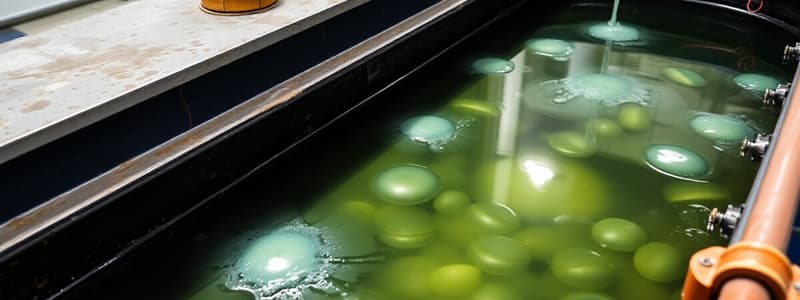Podcast
Questions and Answers
What is the primary purpose of the D-310A/B separators?
What is the primary purpose of the D-310A/B separators?
To separate the cooled reactor effluent into a liquid product stream and a recycle ethylene vapor stream.
How does the T-330 scrubber help prevent issues in downstream equipment?
How does the T-330 scrubber help prevent issues in downstream equipment?
It removes aluminum alkyls that could cause plugging due to ethylene polymerization.
What does the E-330A/B coolers do with the ethylene vapor stream?
What does the E-330A/B coolers do with the ethylene vapor stream?
They cool the ethylene vapor stream using cooling water on the shell side.
What is the role of the D-330 H.P. Recycle K.O. Pot's internal demister pad?
What is the role of the D-330 H.P. Recycle K.O. Pot's internal demister pad?
What action is taken if the T-330 scrubber experiences fouling?
What action is taken if the T-330 scrubber experiences fouling?
Where do the liquid product stream and recycle ethylene vapor stream exit in the D-310A/B separators?
Where do the liquid product stream and recycle ethylene vapor stream exit in the D-310A/B separators?
What materials are the inlet, outlet, and bypass valves of the T-330 scrubber impregnated with, and why?
What materials are the inlet, outlet, and bypass valves of the T-330 scrubber impregnated with, and why?
What is the purpose of the D-345 Continuous Skim Drum?
What is the purpose of the D-345 Continuous Skim Drum?
How does the T-344 Degassing Tower manage the spent caustic?
How does the T-344 Degassing Tower manage the spent caustic?
What is the function of the P-344 Spent Caustic Transfer Pump?
What is the function of the P-344 Spent Caustic Transfer Pump?
Why is the D-350 Water Wash Settler important in the process?
Why is the D-350 Water Wash Settler important in the process?
What happens if the rag layer is allowed to accumulate in the D-350 Water Wash Settler?
What happens if the rag layer is allowed to accumulate in the D-350 Water Wash Settler?
What is the primary function of the hairpin heat exchanger E-320?
What is the primary function of the hairpin heat exchanger E-320?
Describe the design of the static mixer M-320.
Describe the design of the static mixer M-320.
What type of heat exchanger is E-321 and what does it do?
What type of heat exchanger is E-321 and what does it do?
What function does the D-321 Catalyst Blend Drum serve?
What function does the D-321 Catalyst Blend Drum serve?
What is the purpose of the P-321A/B pumps?
What is the purpose of the P-321A/B pumps?
How does M-340 contribute to the caustic wash process?
How does M-340 contribute to the caustic wash process?
What does T-340 do in the caustic wash system?
What does T-340 do in the caustic wash system?
What role does D-340 play in the caustic wash system?
What role does D-340 play in the caustic wash system?
What is the function of the E-340 heater?
What is the function of the E-340 heater?
What is the significance of the skim system in the D-340 Settler?
What is the significance of the skim system in the D-340 Settler?
Flashcards are hidden until you start studying
Study Notes
Reactor Effluent Separators (D-310A/B)
- Dimensions: 8' diameter x 28' 8 5/16" length.
- Function: Separate cooled reactor effluent into liquid product and recycle ethylene vapor streams.
- Configuration: Liquid exits from the bottom; vapor exits from the top.
- Operation: Only one separator in service, the standby separator remains under nitrogen pressure to prevent air ingress.
TEA Scrubber (T-330)
- Dimensions: 3' diameter x 23' 6" length.
- Purpose: Remove aluminum alkyls to prevent downstream plugging due to ethylene polymerization.
- Cleaning: Periodic cleaning necessary due to fouling; equipped with Teflon-impregnated valves for minimized fouling.
- Inlet configuration: Recycle ethylene vapor stream enters from the side bottom, C10-12 stream enters from the side top.
Ethylene Recycle Coolers (E-330A/B)
- Type: Multi-tube U-type heat exchangers.
- Function: Cool ethylene vapor using cooling water; both coolers typically in service.
- Maintenance: Fouling indicated by rising effluent temperatures, necessitating cleaning of the affected exchanger.
H.P. Recycle K.O. Pot (D-330)
- Dimensions: 3' 6" diameter x 7' 9" length.
- Feature: Internal demister pad to remove entrained liquid from cooled ethylene.
- Flow: Ethylene enters from the side; liquid exits from the bottom, vapor from the top.
Catalyzed Product Heater (E-320)
- Design: Hairpin heat exchanger with a unique U-shaped pipe design.
- Function: Heats product stream with 60 psig steam; suitable for limited space and high thermal shock risk.
Static Mixer (M-320)
- Dimensions: 28" long and 6" diameter.
- Use: Mixes 0.2% nickel catalyst into the process without moving parts.
- Spare available featuring an internal baffle design.
Catalyzed Mixing Vessel (D-320)
- Dimensions: 5' diameter x 24' length.
- Purpose: Provides residence time for the nickel-based catalytic reaction; mixed product exits from the top.
Catalyzed Product Cooler (E-321)
- Type: Double-pipe heat exchanger.
- Function: Cools converted product stream using cooling water for heat exchange.
Catalyst Blend Drum (D-321)
- Dimensions: 5' diameter x 6' length.
- Purpose: Dilutes 2% nickel catalyst with C14 to achieve a 0.2% dilution for storage.
Catalyst Solution Injection Pumps (P-321A/B)
- Type: Positive displacement pumps driven by 0.25 HP electric motors.
- Function: Route 0.2% nickel catalyst from blend drum to mixer.
Caustic Wash System
- Consists of static mixers, scrubbers, separators, and circulation pumps to facilitate caustic wash processes.
Spent Caustic System
- Treats spent caustic, separating phases and routing vapors safely to flare systems or sewer lines.
Water Wash System
- Provides a wash process with circulation pumps and heaters to treat hydrocarbon streams and recycle water efficiently.
Maintenance and Safety
- Systems include periodic checks for fouling, operational redundancy, and precautions for vapor control to prevent atmospheric release.
- Skim systems included to manage rag layer accumulation and maintain separation clarity.
Studying That Suits You
Use AI to generate personalized quizzes and flashcards to suit your learning preferences.




